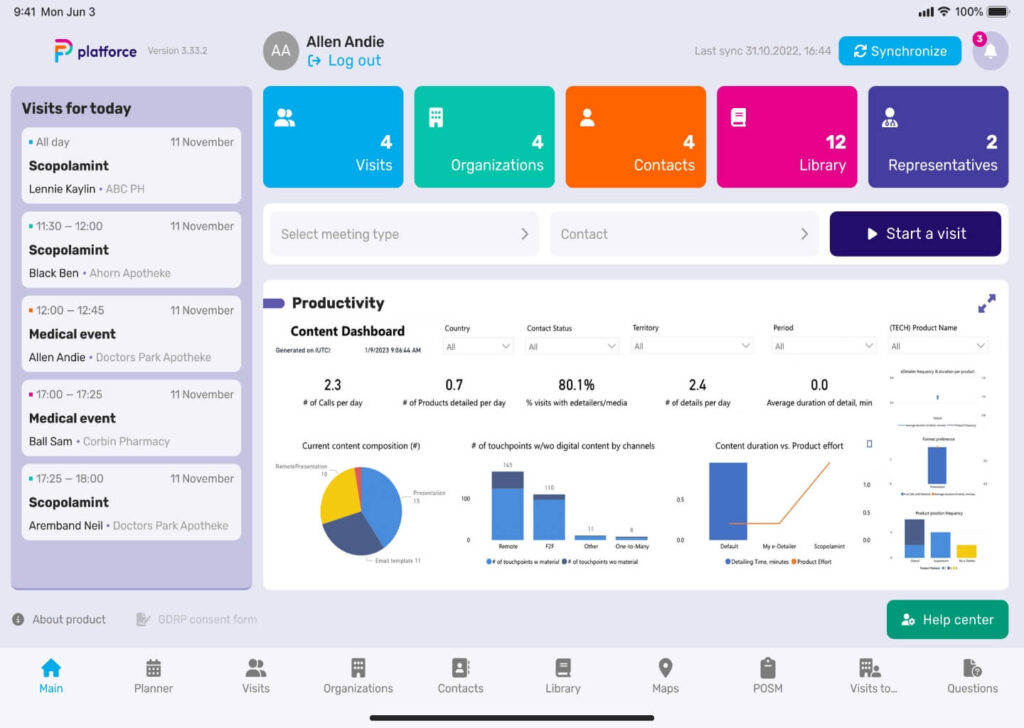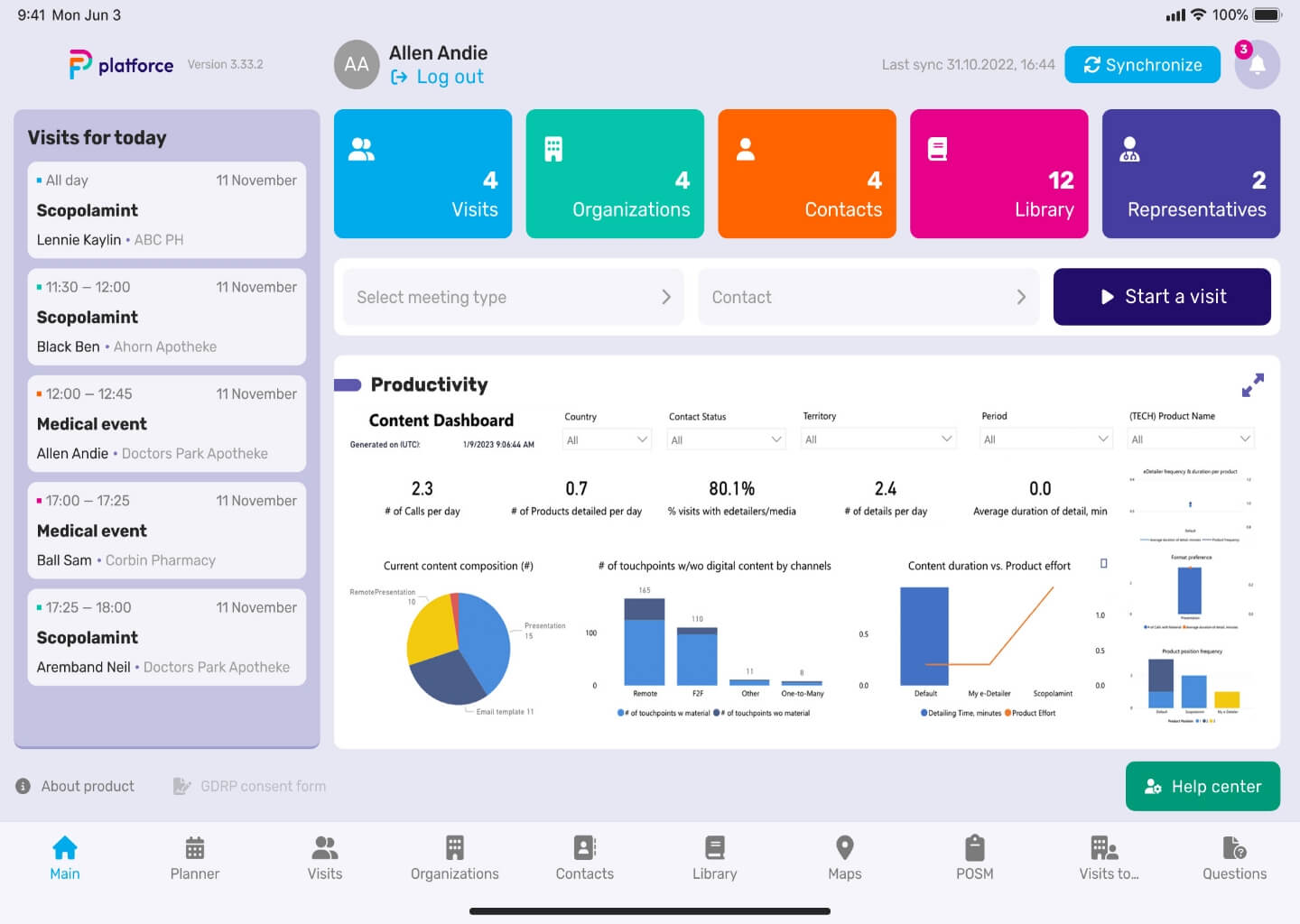In today’s dynamic and highly competitive pharmaceutical industry, data has emerged as a game-changer. With the increasing availability of data and advancements in analytics technologies, pharmaceutical companies are harnessing the power of data-driven insights to drive efficiency, productivity, and innovation throughout the pharmaceutical manufacturing process. This is where Pharma Analytics comes into play.
- What is Pharma Analytics?
- The Power Of Analytics.
- Common Challenges Faced by Pharma Companies in Adopting CRM Pharma Analytics.
- Overcoming Challenges in Adopting CRM Pharma Analytics.
- Unpacking Platforce’s CRM Pharma Analytics
What is Pharma Analytics?
Pharma analytics is the utilization and application of data analytics within the pharmaceutical industry. It empowers companies to unlock valuable insights, streamline operations, and make informed decisions that drive customer engagement and fuel business growth.
By leveraging vast datasets encompassing scientific literature, clinical trial results, genetic information, patient data, and more pharmaceutical professionals can gain a lot.
That being said, let’s look at
The Power Of Analytics.
1.1 Accelerate Research and Development
Pharma analytics plays a pivotal role in accelerating research and development (R&D) activities, which are critical for bringing new drugs and treatments to market. By analyzing vast datasets encompassing scientific literature, clinical trial results, genetic information, and patient data, companies can identify potential drug candidates with higher precision and efficiency.
The ability to integrate and analyze disparate data sources enables researchers to make data-driven decisions, optimize clinical trial design, and identify patient populations that are most likely to benefit from specific treatments.
This targeted approach
- minimizes costs
- reduces time-to-market
- increases the chances of successful product launches.
1.2 Enhance Supply Chain and Manufacturing Processes
Pharma analytics revolutionizes supply chain management and manufacturing processes within the pharmaceutical industry.
By analyzing data related to procurement, inventory management, demand forecasting, and logistics, companies can optimize their supply chain operations.
Real-time data insights enable proactive decision-making, ensuring adequate stock levels, minimizing stockouts, and optimizing distribution networks.
Furthermore, analytics-driven predictive maintenance and quality control processes help identify potential equipment failures, reduce downtime, and ensure consistent product quality, ultimately leading to improved operational efficiency and customer satisfaction.
1.3 Personalize Customer Engagement and Marketing Strategies
Pharma analytics enables companies to understand their customers on a deeper level and deliver tailored experiences. By analyzing patient demographics, preferences, treatment outcomes, and feedback, companies can create personalized marketing campaigns, develop targeted patient support programs, and design customized treatment plans.
Advanced analytics techniques such as predictive modeling and segmentation enable companies to identify patient segments, predict patient behavior, and personalize interactions at scale. This level of customer-centricity not only enhances patient engagement and satisfaction but also contributes to improved health outcomes.
1.4 Ensure Regulatory Compliance and Patient Safety
Pharma analytics plays a critical role in ensuring regulatory compliance and patient safety within the pharmaceutical industry. By analyzing data related to adverse event reporting, pharmacovigilance, and regulatory compliance, companies can detect and respond to potential safety issues more efficiently. Early identification of safety signals allows for timely interventions and mitigation strategies, reducing the risk of harm to patients and ensuring compliance with regulatory requirements. Additionally, analytics-driven compliance monitoring ensures adherence to regulatory standards, streamlines reporting processes, and minimizes the risk of penalties or legal consequences.
1.5 Make Data-Driven Decision
Overall, the power of pharma analytics lies in its ability to drive data-driven decision-making across all facets of the pharmaceutical industry. By transforming raw data into meaningful insights, companies can make informed decisions, identify market trends, seize opportunities, mitigate risks, and optimize their operations. The integration of analytics into strategic planning, resource allocation, and marketing campaigns ensures that decisions are based on evidence and aligned with business goals, leading to improved outcomes, increased profitability, and sustained growth.
While the benefits of pharma analytics are significant, it is important to acknowledge that there are challenges that pharmaceutical companies may encounter when deciding to implement and make use of pharma analytics. Understanding and addressing these challenges is crucial for the successful adoption and utilization of analytics-driven strategies.
Let’s explore some of the;
Common Challenges Faced by Pharma Companies in Adopting CRM Pharma Analytics.
1.1 Data Quality and Integration.
One of the major challenges is ensuring the quality and reliability of data. It’s no surprise that the pharmaceutical industry generates vast amounts of data from various sources, including clinical trials, electronic health records, sales data, and research studies.
However, ensuring the accuracy, consistency, and completeness of data can be complex. On top of that, integrating data from different systems and sources to create a unified view is also challenging, requiring robust data integration processes and technologies.
1.2 Data Privacy and Security.
Pharmaceutical companies handle sensitive and confidential data, including patient information, intellectual property, and clinical trial results.
Protecting this data from unauthorized access, breaches, or misuse is of paramount importance. Compliance with data privacy regulations, such as GDPR and HIPAA, adds an additional layer of complexity.
Implementing robust data privacy and security measures, including encryption, access controls, and anonymization techniques, is essential to maintain trust and meet regulatory requirements.
1.3 Technical Infrastructure and Expertise.
Implementing pharma analytics requires a robust technical infrastructure, including data storage, processing capabilities, and analytical tools. Pharmaceutical companies may face challenges in upgrading or building the necessary infrastructure to handle large volumes of data and perform complex analytics tasks. Additionally, there is a need for skilled personnel with expertise in data analytics, data science, and statistical modeling to extract meaningful insights from the data. Recruiting, training, and retaining such talent can be a challenge.
1.4 Change Management and Cultural Shift.
Integrating analytics into the decision-making processes of a pharmaceutical company often requires a cultural shift and change management. This involves breaking down silos and fostering a data-driven mindset across departments and functions. Resistance to change, lack of understanding about the benefits of analytics, and insufficient training can hinder the successful adoption of analytics-driven strategies. Effective change management, clear communication, and training programs are crucial to overcome these challenges and promote a data-driven culture.
1.5 Cost and Return on Investment.
Implementing and maintaining a robust pharma analytics infrastructure can involve significant upfront and ongoing costs. Investments may be required in hardware, software licenses, analytics tools, data management systems, and talent acquisition. Calculating and demonstrating the return on investment (ROI) of pharma analytics initiatives can also be challenging, especially in the early stages. Establishing key performance indicators (KPIs) and metrics to measure the impact of analytics on business outcomes is essential to justify investments and secure ongoing support.
Addressing these challenges requires a strategic approach, careful planning, and collaboration between IT, data analytics teams, and business stakeholders. Overcoming these obstacles is crucial for pharmaceutical companies to fully leverage the power of pharma analytics and reap its benefits in driving customer engagement and business growth.
In the following sections, we will discuss potential solutions and best practices for addressing these challenges and how a CRM like Platforce can help in ensuring the successful implementation and utilization of analytics in the pharmaceutical industry.
Overcoming Challenges in Adopting CRM Pharma Analytics.
Adopting CRM pharma analytics can present several challenges for pharmaceutical companies. However, with proper planning, strategy, and the right tools, these challenges can be met heads on. Here’s precisely how.
- Ensure Data Quality and Integration.
Data quality and integration are key challenges in fully utilizing pharma analytics. Pharmaceutical companies deal with vast amounts of data from multiple sources, including sales data, customer interactions, and patient information. Ensuring the accuracy, consistency, and completeness of this data is crucial for obtaining reliable insights.
Implementing data governance practices, establishing data quality standards, and leveraging data integration tools from the start can help address these challenges. Plus, regular data validation and cleansing processes should be implemented to maintain data integrity. - Address Data Privacy and Security Concerns.
Pharmaceutical companies handle sensitive patient information and must comply with data privacy regulations such as GDPR and HIPAA. Protecting patient privacy and ensuring data security is a no-brainer under these regulations. Implementing robust data privacy and security measures, including encryption, access controls, and anonymization techniques, is essential. Conducting regular security audits, educating employees on data privacy practices, and adopting secure data storage and transmission protocols can help mitigate these concerns greatly.
- Build Technical Infrastructure.
Fully utilizing analytics in pharma requires a robust technical infrastructure capable of handling large volumes of data and performing complex analytics tasks. This infrastructure includes data storage, processing capabilities, and analytical tools.
Pharmaceutical companies may face challenges in upgrading their existing infrastructure or building a new one. Partnering with experienced technology providers, cloud-based solutions like Platforce, and leveraging scalable analytics platforms can help address these challenges. By utilizing the cloud, companies can avoid significant upfront investments in infrastructure and benefit from the scalability and flexibility offered by cloud-based analytics solutions. - Cultivate a Data-Driven Culture.
Integrating CRM analytics into a pharmaceutical company’s decision-making processes requires a cultural shift and change management. Employees may resist adopting new technologies or be hesitant to rely on data-driven insights. To address this challenge, it is essential to provide training and education on the benefits of CRM analytics. Engage employees at all levels and foster a culture that values data-driven decision-making. Encourage cross-functional collaboration and highlight success stories that demonstrate the positive impact of CRM analytics on business outcomes.
- Demonstrate Return on Investment (ROI)
Justifying the investment in CRM analytics and demonstrating its ROI can be challenging. Pharmaceutical companies need to establish key performance indicators (KPIs) aligned with their business goals and track the impact of CRM analytics on these metrics. Conducting regular performance assessments, monitoring customer engagement, and measuring the success of marketing campaigns can help quantify the benefits of CRM analytics. Demonstrating tangible outcomes, such as increased customer satisfaction, improved sales, and enhanced marketing effectiveness, strengthens the case for continued investment in CRM analytics initiatives.
By addressing these challenges head-on, pharmaceutical companies can successfully unlock the full potential of their customer data. Furthermore, leveraging a comprehensive CRM like Platforce that can provide the necessary tools and functionalities tailored specifically for data analytics in the pharmaceutical industry, streamlines the implementation process and ensures a smooth transition.
Unpacking Platforce’s CRM Pharma Analytics
Platforce’s CRM Pharma Analytics is a powerful tool that empowers pharmaceutical companies to unlock actionable insights, anticipate customer needs, and enhance their marketing strategies. With a range of features designed specifically for the pharmaceutical industry, Platforce’s CRM Pharma Analytics offers a comprehensive solution for harnessing the power of data-driven decision-making.
Let’s delve into the key features and benefits of Platforce’s CRM Pharma Analytics:
- Data Visualization
Platforce’s CRM Pharma Analytics provides robust data visualization capabilities that transform complex datasets into intuitive visual representations. Through interactive charts, graphs, and dashboards, pharmaceutical professionals can gain a comprehensive understanding of their customer data and identify meaningful patterns and trends. Visualizing data allows for quicker and easier interpretation, enabling users to extract actionable insights and make informed decisions.

- Predictive Analytics
Platforce’s CRM Pharma Analytics leverages advanced predictive analytics algorithms to anticipate customer needs and behavior. By analyzing historical data, customer interactions, and market trends, the tool can predict future outcomes, such as customer preferences, medication adherence, and response to marketing campaigns. These predictive insights enable pharmaceutical companies to proactively tailor their strategies, personalize customer interactions, and optimize marketing efforts for improved engagement and higher conversion rates.
- Real-time Reporting
Platforce’s CRM Pharma Analytics provides real-time reporting capabilities, delivering up-to-date insights on key performance indicators (KPIs) and marketing metrics. This enables pharmaceutical professionals to monitor the effectiveness of their campaigns, track sales performance, and identify areas for improvement promptly.
Plus, real-time reporting empowers agile decision-making, allowing companies to make data-driven adjustments and optimize their marketing strategies in real-time, resulting in more impactful and targeted customer engagement.
- Customer Segmentation and Targeting
Platforce’s CRM Pharma Analytics allows for effective customer segmentation and targeting. With advanced analytics techniques, such as clustering and segmentation algorithms, pharmaceutical companies can identify distinct customer groups based on
- Demographics
- Behaviors
- Treatment preferences
- Other relevant criteria
This level of granular segmentation enables personalized communication and tailored marketing campaigns. By understanding the unique needs and preferences of different customer segments, pharmaceutical companies can enhance customer engagement, drive brand loyalty, and maximize the effectiveness of their marketing initiatives.
- Campaign Optimization
With Platforce’s CRM Pharma Analytics, companies can optimize their marketing campaigns by leveraging insights derived from customer data. The tool enables pharmaceutical professionals to evaluate campaign performance, measure return on investment (ROI), and identify the most effective channels and messages for different customer segments. By analyzing campaign data and performance metrics, companies can continuously refine their marketing strategies, allocate resources more effectively, and improve overall campaign effectiveness.
- Compliance and Regulatory Insights
Platforce’s CRM Pharma Analytics helps pharmaceutical companies ensure compliance with regulatory standards and guidelines. The tool provides insights into adherence to compliance requirements, such as tracking consent and permissions, managing data privacy, and maintaining regulatory documentation. By having a comprehensive view of compliance metrics and insights, companies can mitigate compliance risks and streamline their processes to meet regulatory obligations effectively.
Platforce’s CRM Pharma Analytics stands out as a comprehensive solution tailored specifically to the needs of the pharmaceutical industry. By leveraging the powerful combination of data visualization, predictive analytics, real-time reporting, customer segmentation, campaign optimization, and compliance insights, pharmaceutical companies can unlock the full potential of their customer data. With Platforce’s CRM Pharma Analytics, companies can make data-driven decisions, enhance customer engagement, optimize marketing strategies, and drive business growth in the dynamic and competitive pharmaceutical landscape.
Interested?
Platforce is the best CRM software for lead generation, order management, sales automation, and task management. Unlike other software, Platforce gives your company all it needs to optimize customer relations and boost customer experience. Try out the Platforce CRM system with a demo now. You can also stay updated on our Youtube and LinkedIn channels.










